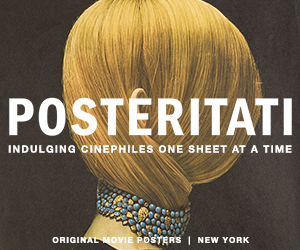She sits, like Dracula, in a high-backed chair in the midst of a dark, cavernous room. Her one hand clutches her knee as if it were a Nosferatu-style claw. As her servant pulls the curtains to shut out the daylight, she entombs her guest, proposing a deal that will end with her living on—at the cost of his life.
It’s no stretch to envision reclusive, former silent film star Norma Desmond (Gloria Swanson) as a vampire, with out-of-work screenwriter Joe Gillis (William Holden) as her Harker. Having rolled onto her estate with a flat tire, he reluctantly agrees to stay, accepting payment to help her polish a screenplay she hopes will be her “return.” Not her “comeback,” for as she famously stipulates: “I am big. It’s the pictures that got small.”
The brilliance of Sunset Boulevard is not that it functions as a Tinseltown Gothic horror, but that it does so while also working as a backstage studio drama, as well as a classic noir. (A noir in which Holden’s objectified writer—even toweling off for Norma in one scene!–is both the hard-boiled narrator and the sexy femme fatale.) Directed by Billy Wilder, who wrote the screenplay with Charles Brackett and D.M. Marshman Jr., the movie takes a perversely co-dependent relationship and blows it up to Hollywood proportions.
Sunset Boulevard also encompasses one of cinema’s grand, melodramatic performances. Swanson—herself a veteran of the silent era and already a two-time Academy Award nominee before receiving her third nod here—plays Norma Desmond as if Norma Desmond believed life was one big, exaggerated silent movie. And so the outsized gestures and grandiose expressions are at once deeply entertaining (notice how rarely she blinks), while also rooted in a real character. There’s a melancholy madness beneath the melodramatic method.
Lamenting to Gillis about the advent of cinematic sound, which pushed her out of the industry, Desmond interestingly frames the transition as avarice—studios chasing new dollars, while betraying their art. “They opened their big mouths and all that came out is talk, talk, talk!” she barks, in a haranguing performance that is in a conversational loop with Bette Davis and Joan Crawford. Swanson’s initial heyday had already passed when Davis and Crawford were in their professional prime, in the late 1930s and 1940s, so Swanson certainly influenced the deliciously vicious women they often played. And without a doubt her Norma Desmond is in the cauldron that Davis and Crawford brewed together in 1962’s Whatever Happened to Baby Jane? Swanson is largely remembered for Sunset Boulevard, but it’s hard to imagine the careers of those two legends without the totality of her contributions to Hollywood—all of which informs the pathos she brings to Norma Desmond.
If you think the movie only sees her as a monster, I’d point you to a crucial sequence, in which Norma pushes her way onto the Paramount Pictures lot to discuss her “return” project with director Cecil B. DeMille (playing himself as a sensitive soul). Not only is DeMille gentle with her, trying not to squash her deluded dreams, but Wilder and cinematographer John F. Seitz anoint her with an angelic air. When a veteran spotlight operator recognizes Norma on DeMille’s set, he turns the beam onto her chair. She exults in it, attracting the attention of the cast and crew, who are delighted by the surprise appearance of a legend. After their effusive praise and requests for autographs, she weeps in gratitude.
The visual ingenuity of that sequence is only one of many aesthetic flourishes to be found in what is of one Wilder’s more filmically ambitious efforts. Sunset Boulevard opens with an unbroken, reverse tracking shot moving down a road, eventually rising to reveal squad cars racing toward Norman Desmond’s mansion. There we find the haunting image of Gillis floating, face down, in her pool. I’d apologize for the spoiler, but the camera is positioned at the bottom of the pool, looking up at his face, the blurry shapes of police officers standing at the edge behind him. Later, once the flashback begins, there’s a wonderful crane shot of Gillis walking up to the mansion’s dilapidated terrace, followed by a slow zoom in on Norma as she watches him from behind the blinds. These are all crime and horror techniques—blended to create something eerie and unnerving, even as it has the faded glamour of old Hollywood.
Sunset Boulevard traded on that glamour to win three Oscars: Art Direction, Screenplay, and Score for Franz Waxman. Like Swanson, Wilder and Holden had to be content with nominations. Hopefully they also took solace in creating what remains the quintessential backstage Gothic noir.
(8/6/2025)



